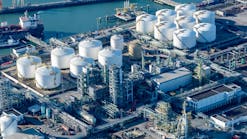ExxonMobil Corp. is moving forward with a planned expansion of its hydrocracking operations at subsidiary Esso Nederland BV’s 191,000-b/d refinery in Rotterdam, Zuid-Holland, Netherlands.
The expanded unit, which will use ExxonMobil’s proprietary hydrocracking technology, is designed to increase the refinery’s ability to upgrade heavier byproducts into high-quality lubricating oils, greases, and ultralow-sulfur diesel, the operator said on Oct. 29.
Following the hydrocracker’s expansion, the Rotterdam refinery will be the first in Europe to produce ExxonMobil’s EHC Group II base stocks, which are designed to meet evolving industry requirements, and help lubricant blenders both to achieve greater formulation flexibility and simplify global qualification testing, according to the company.
With the project’s environmental impact assessment (EIA) already approved and permitting process under way, ExxonMobil said it expects to receive final permits in early 2016, with construction to start soon after.
The company tentatively plans to commission the expanded unit in 2018, pending permit approvals.
ExxonMobil’s investment into the Rotterdam project will amount to more than $1 billion, which alongside the hydrocracker expansion, will include the addition of six new storage tanks that will boost storage capacity at the refinery by 140,000 cu m, the Port of Rotterdam said on Oct. 29.
The Rotterdam project follows a series of previously announced expansions by ExxonMobil to boost production of more profitable products at its Baytown, Tex., Antwerp, Belgium, and Jurong Island, Singapore, manufacturing sites (OGJ Online, Aug. 12, 2015; Aug. 4, 2015; Dec. 17, 2014; July 2, 2014).
The expansion project
According to an EIA for the project filed in late January, the hydrocracker expansion will involve modifications to the refinery’s existing hydrocracker that, among other components, are to include the addition of new reactors and a new vacuum distillation section.
The project will increase the processing capacity of the current hydrocracker—which has a nameplate capacity of 330 tonnes/hr—to 415 tonnes/hr via only minor modifications to the existing installation, ExxonMobil said.
The refinery’s total crude processing capacity of 191,000-b/d will remain unchanged, as the capacity increase will result from use of an existing heavy vacuum gas oil stream (HVGO), which after the expansion, will serve as feedstock for the hydrocracker rather than being sold to market.
ExxonMobil expects the project, once completed, will altogether eliminate the refinery’s output of HVGO and hydrocrackate, according to the EIA.
Contact Robert Brelsford at [email protected].
